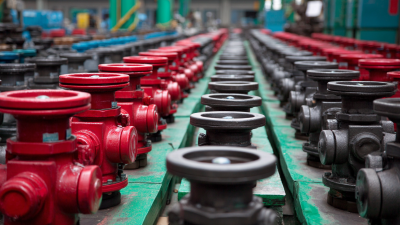
In industrial applications, the efficiency and accuracy of fluid monitoring are critical for operational success. An inline sight flow indicator stands out as a vital tool, providing a clear visual representation of fluid flow within pipes. According to a report by MarketsandMarkets, the global flow measurement market is projected to reach USD 9.2 billion by 2025, driven by increasing automation across various industries. As companies aim for greater efficiency and compliance with safety regulations, selecting the appropriate inline sight flow indicator becomes paramount. This choice not only affects process visibility but also impacts maintenance and cost-effectiveness. Understanding the different types and features available in the market is essential for meeting specific industrial requirements, ensuring that businesses can optimize their fluid management systems effectively.

Inline sight flow indicators are vital tools in various industrial applications, offering real-time visualization of fluid movement within pipelines. By allowing operators to see the flow of liquids or gases, these devices enhance process monitoring and control, making them essential in industries such as water treatment, oil and gas, and pharmaceuticals. The ability to instantly detect changes in flow can help identify potential issues before they escalate, leading to increased efficiency and reduced downtime.
When choosing the right inline sight flow indicator, it's important to consider factors such as fluid type, temperature, pressure, and the specific requirements of your application. Different models offer varying levels of visibility and design features, from simple glass tubes to advanced plastic or stainless-steel constructions. Additionally, some flow indicators come equipped with built-in sensors for more precise flow measurement and monitoring, which can provide valuable data for process optimization. Understanding the specific needs of your operation will guide you toward selecting the most suitable inline sight flow indicator, ensuring both performance and reliability in your industrial processes.

When selecting an inline sight flow indicator for your industrial needs, understanding the key factors involved can greatly enhance operational efficiency. One of the primary considerations is the material compatibility. According to industry reports, nearly 60% of flow indicator failures are attributed to materials that are not suited to the type of fluid being monitored. Therefore, ensure that the construction materials of the indicator (such as glass or polycarbonate) are appropriate for the chemical properties of the fluid.
Another critical aspect is the flow rate and pressure range. Indicators must be capable of functioning reliably within the specific flow conditions of your application. A recent study revealed that indicators that are not properly calibrated to the flow range can lead to malfunction, causing significant downtime in production. It’s advisable to consult flow data reports to determine the optimal specifications needed for your system.
Tips:
When selecting inline sight flow indicators for industrial applications, it’s crucial to consider material compatibility, especially in harsh environments. These indicators are often exposed to extreme temperatures, corrosive substances, and mechanical stress, making the choice of materials that can withstand such conditions vital for ensuring durability and reliability. Materials like stainless steel or certain high-grade plastics can provide the necessary resistance to chemical attacks and physical wear, extending the lifespan of your flow indicators.
**Tips:** When evaluating material options, always check for certifications that specify resistance to the chemicals involved in your processes. Additionally, consider the operating temperature range and mechanical load your flow indicator will experience. It may also be beneficial to consult with manufacturers about their material testing results to ensure that their products will meet your industrial needs effectively.
In the realm of advancements, companies are innovating with robust designs to enhance performance. Understanding the environment where your inline sight flow indicator will operate can guide you towards the best choice, ensuring that it performs effectively while requiring minimal maintenance.
| Indicator Type | Material | Temperature Range (°F) | Pressure Rating (PSI) | Applications |
|---|---|---|---|---|
| Glass Flow Indicator | Borosilicate Glass | -40 to 300 | 150 | Chemical Processing, Water Treatment |
| Plastic Flow Indicator | Polycarbonate | 32 to 140 | 100 | Food and Beverage, HVAC |
| Metal Flow Indicator | Stainless Steel | -50 to 400 | 300 | Oil and Gas, Marine Applications |
| Magnetic Flow Indicator | PTFE Coated | -20 to 250 | 200 | Pharmaceuticals, Chemical Processing |
| Turbine Flow Indicator | Aluminum | -40 to 200 | 150 | Water, Airflow Monitoring |
When selecting an inline sight flow indicator for industrial applications, one of the most critical factors to consider is the flow rate specifications. Each system has unique requirements that can significantly impact the efficiency and reliability of operations. To ensure optimal performance, it is essential to match the specifications of the indicator with the specific flow rates of your system. Oversized or undersized indicators may lead to inaccurate readings, resulting in operational inefficiencies and potential hazards.
Moreover, understanding the interplay between flow rate and the overall system design is essential. This involves examining factors such as temperature, pressure, and the nature of the fluid being measured. For instance, in applications involving liquid as a heat transfer medium, the design of the indicator must accommodate variations in viscosity and other fluid properties. By paying close attention to these specifications, you ensure that the chosen flow indicator not only meets current demand but is also adaptable for future changes in system requirements, ultimately enhancing the overall effectiveness of your industrial processes.

Proper maintenance and calibration of inline sight flow indicators are critical to ensuring their longevity and accuracy in industrial applications. According to a 2022 report by the Flow Measurement and Control Association (FMCA), regular calibration improves the reliability of flow measurement by up to 15%, significantly impacting process efficiency. It's recommended that operators perform routine checks every three to six months, depending on the specific environmental conditions and the fluid characteristics involved. For example, indicators in corrosive environments may require more frequent inspections to detect wear or damage early.
Best practices for maintenance include cleaning the flow indicator regularly to prevent build-up that could obscure visibility or disrupt flow. A study from the Industrial Flow Society in 2023 found that nearly 30% of flow indicator failures can be attributed to neglecting cleaning protocols. Additionally, recalibrating after any significant changes in process conditions or after maintenance ensures that the flow readings remain precise. Utilizing calibrated standards and following manufacturer guidelines will enhance the performance and lifespan of your flow indicator, ultimately contributing to a more efficient operation in your facility.





